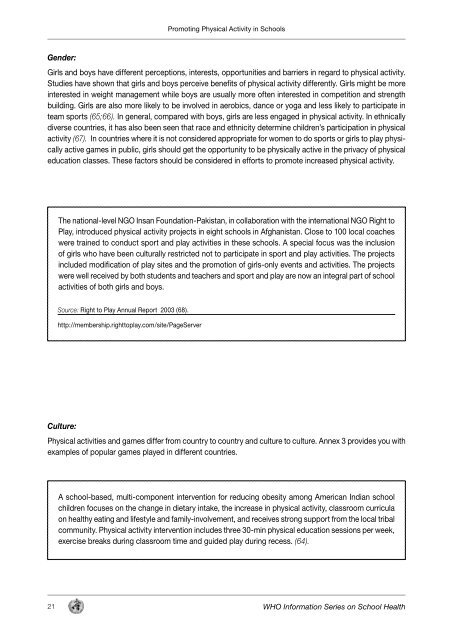WHO INFORMATION SERIES ON SCHOOL HEALTH ... - PAHO/WHO
WHO INFORMATION SERIES ON SCHOOL HEALTH ... - PAHO/WHO
WHO INFORMATION SERIES ON SCHOOL HEALTH ... - PAHO/WHO
You also want an ePaper? Increase the reach of your titles
YUMPU automatically turns print PDFs into web optimized ePapers that Google loves.
Gender:<br />
21<br />
Promoting Physical Activity in Schools<br />
Girls and boys have different perceptions, interests, opportunities and barriers in regard to physical activity.<br />
Studies have shown that girls and boys perceive benefits of physical activity differently. Girls might be more<br />
interested in weight management while boys are usually more often interested in competition and strength<br />
building. Girls are also more likely to be involved in aerobics, dance or yoga and less likely to participate in<br />
team sports (65;66). In general, compared with boys, girls are less engaged in physical activity. In ethnically<br />
diverse countries, it has also been seen that race and ethnicity determine children’s participation in physical<br />
activity (67). In countries where it is not considered appropriate for women to do sports or girls to play physically<br />
active games in public, girls should get the opportunity to be physically active in the privacy of physical<br />
education classes. These factors should be considered in efforts to promote increased physical activity.<br />
The national-level NGO Insan Foundation-Pakistan, in collaboration with the international NGO Right to<br />
Play, introduced physical activity projects in eight schools in Afghanistan. Close to 100 local coaches<br />
were trained to conduct sport and play activities in these schools. A special focus was the inclusion<br />
of girls who have been culturally restricted not to participate in sport and play activities. The projects<br />
included modification of play sites and the promotion of girls-only events and activities. The projects<br />
were well received by both students and teachers and sport and play are now an integral part of school<br />
activities of both girls and boys.<br />
Source: Right to Play Annual Report 2003 (68).<br />
http://membership.righttoplay.com/site/PageServer<br />
Culture:<br />
Physical activities and games differ from country to country and culture to culture. Annex 3 provides you with<br />
examples of popular games played in different countries.<br />
A school-based, multi-component intervention for reducing obesity among American Indian school<br />
children focuses on the change in dietary intake, the increase in physical activity, classroom curricula<br />
on healthy eating and lifestyle and family-involvement, and receives strong support from the local tribal<br />
community. Physical activity intervention includes three 30-min physical education sessions per week,<br />
exercise breaks during classroom time and guided play during recess. (64).<br />
<strong>WHO</strong> Information Series on School Health

















